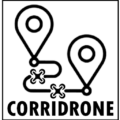EXPERIMENTAL DEMONSTRATION VIDEOS
Experimental demonstrations are carried out to validate the feasibility of drone corridors for aerial locomotion. Some of these experiments are carried out inside a lab, while others are in the open sky. A motion capture system is used for lab demonstrations, and for open sky demonstrations, an RTK GPS is used.
RECTANGULAR DRONE CORRIDOR
The video demonstrates the locomotion of a quadcopter inside a rectangular corridor. The experiment had the waypoints as the user inputs, five of which are required to complete a rectangular loop. Using these waypoints, the CORRIDRONE server creates a virtual keep-in geofence and communicates it to the drone’s autopilot. This geofence allows its controller to maintain a certain forward speed while keeping itself well within the boundaries of the lane.
MULTI-LANE DRONE CORRIDOR
An experimental demonstration shows the locomotion of UAVs inside two lanes that are horizontally aligned with a separation between them to maintain a safe distance between drones. The corridor waypoints are the inputs the user provides. The CORRIDRONE server generates lanes in a horizontal direction with an offset from the center. The UAVs are seen to be maintaining their position within the corridor lanes apart from each other as designated.
HORIZONTALLY ALIGNED LANES IN A CORRIDOR
VERTICALLY ALIGNED LANES IN A CORRIDOR
The video depicts an experimental demonstration of the locomotion of UAVs inside two vertically aligned lanes. These lanes are separated to keep a safe distance between drones, considering the downwash effects of one UAV on another. With the corridor waypoints as the inputs, the CORRIDRONE server generates lanes vertically with an offset from the center. The UAVs maintain their position within the corridor lanes apart from each other, as stipulated.
CONFLICT RESOLUTION WITH SPEED SCHEDULING
A sample hardware demonstration for intersection planning algorithm for two crazyflies with their trajectories intersecting at a perpendicular angle starting at a random initialized position. The UAVs reach the initial position of the waypoints provided and start tracking it. UAV velocities were assigned such that they avoid being at a location at the same time. The distance between UAVs was maintained well above the minimum desired separation needed.
MULTI-LANE CORRIDOR VISUALIZATION
A visualization of a 10-laned corridor planned in an obstacle-rich environment is shown in the video. The simulation is carried out with the help of ROS, Gazebo, and Rviz. The drone compliance level, size, and downwash effects of one drone on another, along with a few other constraints, are imposed on the system while planning the corridor path and cross-section. A fixed separation of the corridor is maintained from the obstacles.
CORRIDRONE GROUND STATION GUI
A GUI is developed to monitor the state of a UAV inside the corridor, which can be divided into three parts. The leftmost part is for geofence monitoring, featuring a graphical representation of the UAV’s position in the geofence cross-section and a few action regulators to take corrective measures during an emergency. The middle part features a set of gauges representing the live states of the UAV, i.e., altitude, heading, horizon, speed, GPS accuracy, and battery status. The rightmost part of the GUI features the planned lane and corridor information, i.e., lane id, cross-section, path length, priority level, and the number of intersections, among others, along with a 2D map.
GEOFENCE BOUNDARY MAINTAINANCE
The simulation video shows a quadrotor navigating inside a spiral geofence, simulated in Gazebo and visualized in RViz. An Iris quadrotor is used with a PX4 autopilot to perform the simulation. A terminal on the top left of the screen shows the distance of the UAV from outer geofence at a given time. The negative sign on the distance indicates that it always stays within the geofence.

